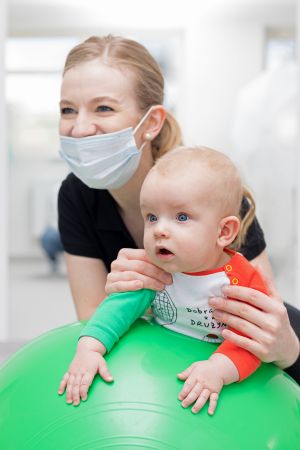Child therapy

Assessment and rehabilitation of infants
Three levels of intervention:
-
Assisting in the processes of maturing the child's competences and skills
It is a precisely planned and implemented way of arranging the environment and everyday activities of the child and the family, so as to ensure optimal conditions for its development. It is implemented when a premature baby shows developmental features justified by immaturity and history. One of the elements of supporting development is the Handling system. In short, these are universal, adaptable methods and strategies for dealing with the baby in all everyday activities: care, bathing, feeding, changing diapers and positions, lifting, carrying, putting away, playing and all possible events and activities that parents do in front of, with and for the child. These techniques also help facilitate the child's spontaneous activity. Handling is based on child handling techniques developed by the NDT-Bobath school of neurodevelopmental therapy. Without this element, it is difficult to imagine any stimulation of development, at any age and developmental level of a child.
-
Early development stimulation
Basically every action towards another person is some kind of stimulation. In this case, however, it is about the techniques of modifying the child's behavior and activity with the use of precise techniques and arrangement of the environment, so as, on the one hand, to facilitate their activity at any time with the use of the most correct mechanisms of movement, posture and behavior. On the other hand, to limit the moments and activities in which the child uses incorrect, yet non-pathological mechanisms of movement, posture and behavior.
-
Therapy
The most advanced, specialized form of intervention, which integrates into the previous two forms, additionally uses highly specialized techniques of individual therapy schools. The most advanced measures are recommended in the case of identified or highly probable serious disorders, dysfunctions or diseases and / or their possible complications.
Infant rehabilitation
-
Assessment of psychomotor development of premature babies and infants from high-risk groups.
-
Forecast of psychomotor development of premature babies and infants based on standardized assessment tests according to Prechtl and TIMP (Test of Infants Motor Performance).
-
Therapy of premature babies and infants at risk of developing cerebral palsy.
-
Therapy of premature babies and infants with tension disorders, postural asymmetry, psychomotor retardation.
-
Therapy of infants with congenital foot defects (clubfoot, horse foot).
-
Therapy of infants with torticollis.
-
Therapy of infants with perinatal damage to the shoulder plexus.
-
Therapy of infants with birth defects (meningeal hernia, arthrogryposis, achondroplasia, etc.).
-
Therapy of infants with genetic syndromes (Down syndrome, Lowe's syndrome, Prader-Willi syndrome, etc.).
-
Instruction on proper care and simple exercises and games for parents.
- Kinesiotaping (therapeutic taping) supporting therapy.
Make an appointment or find out more - Call us!
